Clostridium perfringens (pər-frĭn’jənz), is a bacterium common among food-borne illness and tends to thrive in conditions that are slightly above room temperature. The spore-forming bacterium can also grow when foods are not properly cooled or are held at room temperature too long.
The dozens of Portland sixth-graders wracked with cramps, vomiting and diarrhea at an outdoor school excursion fell sick from a tainted batch of chuck roast, egg noodles and sour cream, the Multnomah County Health Department said Monday.
Health inspectors concluded that Clostridium perfringens was behind the mysterious illness that tormented 60 Portland Public School students at the Sandy River Outdoor School on Oct. 8 and rattled scores of parents.
C. perfringens is ever present in nature and can be found as a normal component of decaying vegetation, marine sediment, the intestinal tract of humans and other vertebrates, insects, and soil.
The gases form bubbles in muscle (crepitus) and the characteristic smell in decomposing tissue, whether vegetable, animal, or human.
The action of C. perfringens on dead bodies is known to mortuary workers as tissue gas and can be halted only by embalming.
Another recently reported case shows how this usually happens. A lady made a pot of chili which she served to her family. The pot was to big to fit in the refrigerator, so she left it out on the counter. The next night she reheated it and served it to her family. In three hours they were all in the hospital, including the dog which ate the leftovers.
Here’s the thing. The reheating (even at the proper temperature of 160 degrees), may have reduced the C. perfringens to safe levels, but the toxins produced by it as it enjoyed a very favorable growing environment, could no be removed even at 500 degrees.
